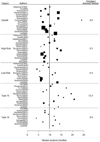Patterns of persistent genital human papillomavirus infection among women worldwide: a literature review and meta-analysis
- PMID: 22961444
- PMCID: PMC3707974
- DOI: 10.1002/ijc.27828
Patterns of persistent genital human papillomavirus infection among women worldwide: a literature review and meta-analysis
Abstract
Persistent high-risk human papillomavirus (HR-HPV) infection is the strongest risk factor for high-grade cervical precancer. We performed a systematic review and meta-analysis of HPV persistence patterns worldwide. Medline and ISI Web of Science were searched through January 1, 2010 for articles estimating HPV persistence or duration of detection. Descriptive and meta-regression techniques were used to summarize variability and the influence of study definitions and characteristics on duration and persistence of cervical HPV infections in women. Among 86 studies providing data on over 100,000 women, 73% defined persistence as HPV positivity at a minimum of two time points. Persistence varied notably across studies and was largely mediated by study region and HPV type, with HPV-16, 31, 33 and 52 being most persistent. Weighted median duration of any-HPV detection was 9.8 months. HR-HPV (9.3 months) persisted longer than low-risk HPV (8.4 months), and HPV-16 (12.4 months) persisted longer than HPV-18 (9.8 months). Among populations of HPV-positive women with normal cytology, the median duration of any-HPV detection was 11.5 and HR-HPV detection was 10.9 months. In conclusion, we estimated that approximately half of HPV infections persist past 6 to 12 months. Repeat HPV testing at 12-month intervals could identify women at increased risk of high-grade cervical precancer due to persistent HPV infections.
Keywords: HPV; cervical cancer; clearance; duration; human papillomavirus; literature review; meta-analysis; natural history; persistence; repeat testing; screening.
Copyright © 2012 UICC.
Conflict of interest statement
Dr. Anne Rositch was directly supported for this project by GlaxoSmithKline (GSK) from 2006–2008 as a Graduate Student in the Department of Epidemiology at the University of North Carolina and was a Graduate Research Assistant at GSK from 2008–2009; Dr. Jill Koshiol was employed part-time by GSK from 2001–2005; Dr. Michael Hudgens, no conflict; Hilda Razzaghi has worked as a Graduate Research Assistant at both GSK and Merck in the last five years; Dr. Danielle Backes, no conflict; Dr. Jeanne Pimenta is an employee of GSK; Dr. Eduardo Franco has occasionally served on advisory boards at GSK, Merck, Roche, and Gen-Probe; Dr. Charles Poole receives partial salary support and has received lecture honoraria from GSK; Dr. Jennifer Smith has received grants and consulting fees in the last six years from GSK, Merck, Hologic, Qiagen, and Gen-Probe.
Figures







References
-
- Munoz N. Human papillomavirus and cancer: the epidemiological evidence. Journal of Clinical Virology. 2000;19:1–5. - PubMed
-
- Walboomers JM, Jacobs MV, Manos MM, Bosch FX, Kummer JA, Shah KV, Snijders PJ, Peto J, Meijer CJ, Munoz N. Human papillomavirus is a necessary cause of invasive cervical cancer worldwide. The Journal of pathology. 1999;189:12–19. - PubMed
-
- IARC Monographs on the Evaluation of Carcinogenic Risks to Humans Monograph on human papillomavirusesed. vol. 90: International Agency for Research on Cancer. 2007
Publication types
MeSH terms
Grants and funding
LinkOut - more resources
Full Text Sources
Medical
Miscellaneous

